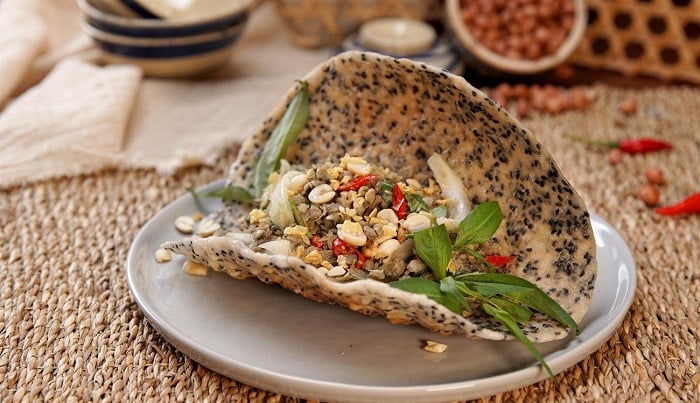- Address: Vinh Market – Hong Son, Vinh City, Nghe An

Banh Da is a dish that can be found everywhere, but to be as delicious as in Do Luong, Nghe An, not everywhere can compare. The cakes here are made from rice flour, pepper, garlic and other spices. It sounds simple, but the way to make the cake is also a lot of stages.
People will have to use a little plasticity, no impurities, and then grind it, mix it with black sesame and some other necessary spices. It is then coated with an autoclave and then dried. When buying Do Luong dry rice paper to take home, you can bake it yourself and eat it directly or eat it with other dishes.
Source: Collected internet.
The specialties of each region of Vietnam carry within themselves the local lifestyle and the quintessence of nature there. The North cherishes delicate recipes, like a delicious bowl of bun thang that must be prepared for many hours. In the Central region, royal culinary traditions and typical spices blend in unique dishes such as lotus rice or spring rolls. Southern braised fish and sour soup come from abundant seafood resources, the pride of the Mekong Delta.
The Vietnam National Gene Bank preserves 12,300 varieties of 115 species. The Vietnamese government spent US$497 million to maintain biodiversity in 2004 and has established 126 protected areas including 28 national parks. Vietnam has 2 world natural heritage sites: Ha Long Bay and Phong Nha - Ke Bang National Park and 6 biosphere reserves including Can Gio, Cat Tien, Cat Ba, Kien Giang, and River Delta mangrove forests. Hong and Tay Nghe An.
Vietnam's history began from 1 to 2 thousand years BC. Over many centuries with the Ly, Tran, Le, and Nguyen dynasties, from the mid-19th century, Vietnam became a French colony. After the August Revolution, the Democratic Republic of Vietnam was born. The Battle of Dien Bien Phu in 1954 marked the end of the French in the territory, but Vietnam was divided into two countries: the Democratic Republic of Vietnam in the North and the Republic of Vietnam in the South. After the events of April 30, 1975, Vietnam was unified and from July 2, 1976, officially named the Socialist Republic of Vietnam.
The relic cluster of Ba Om Pond, Ang Pagoda, and Museum of Khmer Ethnic Culture located in Ward 8, Tra Vinh city is a famous scenic spot, cultural and historical relic of Tra Vinh province as well as the whole region. Mekong Delta region. This is also the pride of the KhMer bronze treasure.